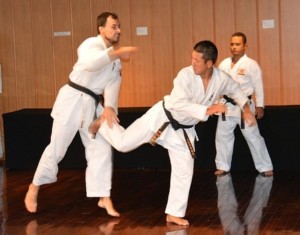Every male knows it’s really painful to get hit in the groin area. Even thinking about it hurts. A baseball takes an unexpected bounce, an opponent misses a kick on the soccer field and his foot has only one place to go, you are speeding along on your bike and you hit a bump—all result in really one painful thing: a shot to the testicles, one of the most tender areas on a man’s body. This has happened to all of us. But is there a time when you really have to worry?
The good news is, because the testicles are loosely attached to the body in the scrotum and are essentially made of a spongy material, they are able to absorb most collisions without permanent damage. You will definitely feel pain if your testicles are struck or kicked. You might also feel nauseated for a short time. If the testicular injury is minor, the pain should gradually subside in less than an hour, and any other symptoms should go away as well.
However, if the pain is sudden in onset and the scrotum is swollen or bruised, and if you have nausea and vomiting that lasts for more than an hour, this is a true urologic emergency. You must immediately see a doctor because you could have testicular torsion, which occurs when the testicle rotates around the spermatic cord. The testicle is attached to the end of this cord and hangs in the  scrotum. The spermatic cord contains an artery to the testicle, a vein from the testicle, and a vas deferens, which carries sperm from the testicle to the prostate area. When this cord suddenly twists, the arterial blood supply to the testicle is immediately strangled, and the testicle can literally die from the lack of circulation. This twist or rotation causes sudden and severe pain and swelling. It often occurs spontaneously, sometimes when a man is sleeping, or it can come following straining or trauma.
scrotum. The spermatic cord contains an artery to the testicle, a vein from the testicle, and a vas deferens, which carries sperm from the testicle to the prostate area. When this cord suddenly twists, the arterial blood supply to the testicle is immediately strangled, and the testicle can literally die from the lack of circulation. This twist or rotation causes sudden and severe pain and swelling. It often occurs spontaneously, sometimes when a man is sleeping, or it can come following straining or trauma.
Most cases of testicular torsion occur in younger men ages 12–25; however, although uncommon, it can happen in older men as well. No matter your age, torsion of the testicle is a medical emergency. Unless it is corrected, the testicle will be lost. If the torsion is discovered and corrected within the first 6–8 hours after occurring, the testicle will be saved more than 90 percent of the time. After 12 hours, the chances of salvaging the testicle fall dramatically. After 24 hours, the testicle cannot be saved, no matter what is done. This will result in the loss of the testicle’s function and may affect fertility.
If the torsion is discovered in a timely manner, the surgery is simple and straightforward. A small slit is made in the scrotum by the surgeon and a suture is used to attach the testicle to the scrotal wall in such a manner that the testicle is unable to twist. The surgery is usually done on both sides as a preventive measure.
The takeaway message is this: “Not all testicular pain is equal.” If the testicular pain is sudden in onset and lasts more than one hour, a diagnosis of testicular torsion is likely. Testicular torsion is a true emergency and must be fixed in a timely manner.


